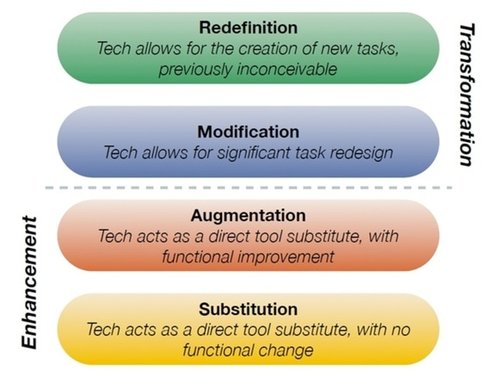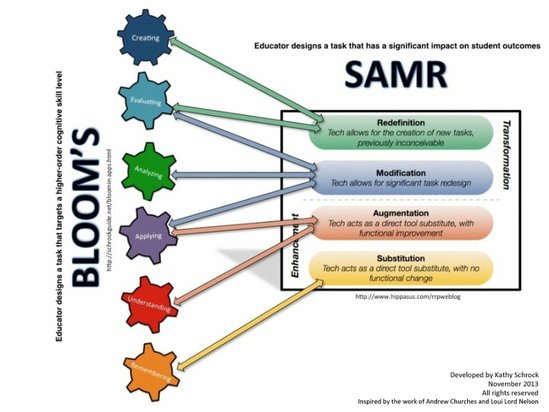|
Today's Tech Tip Tuesday is focused on the SAMR model. Designed by Dr. Ruben Puentedura, the model helps educators design, develop, and incorporate educational technology into learning experiences. SAMR stands for Substitution, Augmentation, Modification, and Redefinition. Below is an image of the model. Notice how each area either falls in Enhancement or Transformation. I think it is important to note that there is no "bad" area of this model. Meaning, all teachers will fall somewhere in one of these four areas at any time, depending on the lesson. Remember, we always consider TPACK when planning our lessons. That means considering what we want to teach and how we want to teach it before deciding if (and how) technology will support the learning. Consider SAMR as a ladder: How can you get from enhancing learning to transforming learning in your classroom? Some lessons are appropriate at the Substitution and Augmentation level, but many lessons can rise above the line to become transformative learning experiences for your students. Consider how you use texts in your classes. If a student uses an e-Book instead of a physical textbook that is considered Substitution. Now consider how you can move up the ladder. How about if students use an e-Reader with apps that allow annotations and highlighting? That would be considered Augmentation. Now let's take it a little further. Right now the student is working in isolation, but what if she could communicate with others about her reading? Using technology to allow communication about the text would be considered Modification. Finally, allowing your students to analyze the reading in a blog or continue the conversation over Twitter would be considered Redefinition. Now you got it! There are a number of questions you can ask yourself to move up the SAMR ladder. If you want to go from Substitution to Augmentation, ask yourself what ways can you make the lesson more engaging with technology? If you want to move to Modification, ask yourself are there ways to give more control to the learner and/or ways to make the learning more authentic to the learner? Finally, if you want to move to Redefinition ask yourself what would you do in your ideal teaching world if you had no limits? How can you transform the learning with your students? SAMR helps educators design learning tasks that have significant impact on student outcomes. Kathy Schrock extended this thinking by making connections to the updated Bloom's Taxonomy as seen in the image below. Not only should we design learning that targets higher-order thinking skills as seen in Bloom's Taxonomy, but we need to design learning that also has an impact on student outcomes. Therein lies the connection between Bloom's and SAMR, and they go hand-in-hand. We are already designing learning that builds on the levels of Bloom's; now we can use SAMR to also consider learning outcomes. Not only that, but both help guide the successful and effective introduction and continuing use of educational technology in learning. Want to learn more about these connections? Here is Dr. Puentedura's take on the topic, and here are Kathy Schrock's ideas on the topic. Want to learn more or see great SAMR examples? Check out the links below. 8 Examples of Transforming Lessons with SAMR SAMR Flowchart SAMR Through the Lens of 21st Century Skills Assessing Yourself in Using SAMR and Transforming Learning (Rubric) SAMR Model Explained By Students How are you using SAMR? Leave a comment to join the discussion. Your comment will be posted after it is approved.
Leave a Reply. |
Archives
April 2017
Categories
All
|


 RSS Feed
RSS Feed
